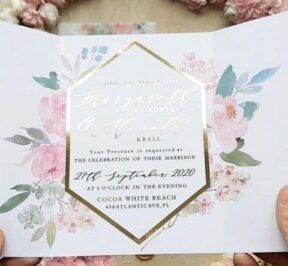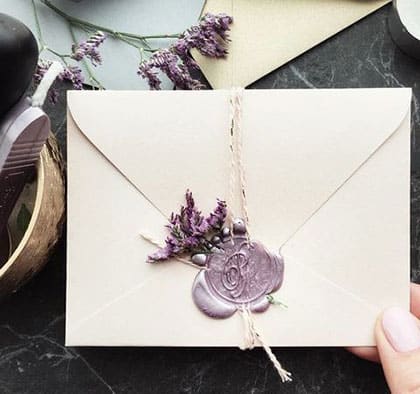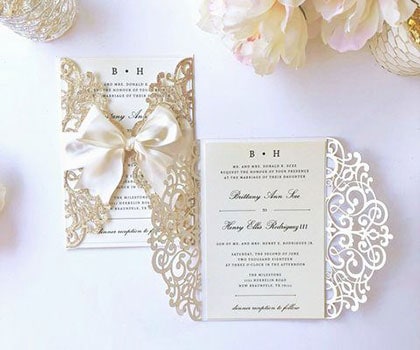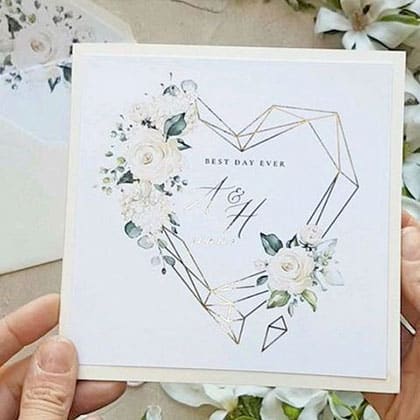
Sep 05
Perfect Wedding Invitations – Guest List Variations and Send out Ideas
Preliminary Preparations for Wedding Invitations
The invitation sets the tone of your wedding and should reflect the ideas that came from your wish list. Having compiled this, you will know if you want your wedding to be formal, fun, posh or homespun.
It is important to check the capacity of the church, register office or approved premises before deciding how many guests to invite to the ceremony and ascertain how many can be catered for at the reception.
□ Decide how many guests you would like to invite to the ceremony and the reception
□ Produce a schedule with the suggested columns: Name and Address, Tel. No., No. of children, Accepted, Refused
□ Decide whether you wish to invite couples with babies or young children
□ Prepare a guest list for the ceremony and reception and have some names in reserve
□ Prepare a separate guest list for the evening reception and have some names in reserve
□ Determine how many invitations are required
□ Decide whether it is appropriate to include any guidance on dress or theme
□ Place the order and confirm the required date of supply
□ Decide whether you will include an invitation reply card
□ Send out the invitations at least six weeks before the wedding and state whether a guest may bring a partner
□ Record responses as they arrive and send out invitations to people on the reserve list if numbers permit
□ Acknowledge invitation replies
• send a wedding gift list or information pack (with reply or on request)
• enclose a map of the ceremony and reception venues
• include a list of nearby hotels and guesthouses with prices where appropriate
• ask to be notified of any special requirements such as diet, e.g. vegetarian, kosher or allergies, highchairs for babies and wheelchairs for any elderly or disabled guests
Think about the Number of the Wedding Invitations
Work out how many invitation cards you need, rather than counting the number of guests you have coming. It sounds obvious, but it is an easy mistake to think you’ve got 80 guests and assume you need 80 invitations, when many will be couples or families. Allow for a few extra cards in case you make mistakes when you are filling in the names, or if you get refusals and want to invite other people. But remember that other stationery, such as order of ceremony sheets, should be calculated on the number of guests.
Stationery and Wedding Invitations’ Style
Your wedding invitations are the first glimpse your guests will get of your wedding day, so it’s important to make a good first impression. As well as letting them know the all-important details of the day such as date, time and location, your wedding invitations will give them an idea of the tone and theme of your wedding. Choose stationery in complementary colours and styles to match your colour scheme or theme.
□ Decide whether to write your own or have them printed
□ Choose a style to suit the wedding (formal, traditional or modern)
□ Size and shape (rectangular, wedding bell, heart, etc.)
□ Background colour – colour of lettering, typeface, border, motif
□ Compose appropriate wording to complement the style of card chosen and decide whether to include a space for your guests’ names
□ Arrange for a proof
Order of Service Sheets in Your Wedding Invitations
□ Discuss the order of Service with the officiant
□ Decide on a suitable style
□ Shape and size
□ Background colour of lettering typeface border motif
□ Arrange for a proof and check carefully
□ Determine how many you will require
One per guest, officiant, organist and each member of the choir, plus mementoes
□ Place the order and confirm the required date of supply
Compose Appropriate Wording for Your Invitations
Wording Traditionally, an invitation would say: ‘hosts’ names [which may be parents] request the pleasure of guests’ names to attend the wedding on date, time, place, etc.’. It is probably a rare occasion when parents are paying for a civil partnership, but if this is the case, you may want to include them on the invitation in a more informal way. For example: ‘Joanne and Mary, along with their parents, would like to invite…
You also need to include, either on the invitation or on a separate insert, essential information such as the date, time, address of venue for ceremony and reception, directions by road and public transport, parking arrangements, dress code, local accommodation, address for RSVP, mobile phone number for emergencies on the day, dietary requirements, latest date for RSVPs, and gift list details. Also make it clear if children are invited.
Wedding Invitation Design
If you want handmade or bespoke stationery, there is a wide range of gay-friendly designers. If you decide on a bespoke design, sit down with the designer and look at previous examples of their work. Be honest about what you like and dislike, so that they can build up an idea of your tastes. It is a good idea to go armed with a large sheet of paper displaying images you have cut out from magazines, showing the colours and styles that appeal to you – this is sometimes known as a mood board. If you do create one, it will also be useful if you are having other elements of your civil partnership designed, such as outfits and even the decoration for the room. Ideas range from invitations cut into a shape to represent your theme to an invitation wrapped up in a scroll and even placed in a bottle.
You may want to employ a professional calligrapher to write the invitations, and then you won’t have to worry that your writing won’t match up to the standard of the stationery. Remember to factor in the time needed for this. Once you have agreed on the design elements with your stationer, they should prepare a few samples for your approval.
Hiring a Wedding Invitation Designer
If you engage a designer, they ideally need two to three months to take your brief, show you proofs, finalise the design and either hand make the stationery or send them to print. Although, you can always get things done quickly if you’re in a hurry. Some stationers could turn an invitation around in five days, but at a premium.
Ask to see a sample of your invitation in your chosen colour theme before you commit to any order. Also, ask for a paper copy of the design. If it is sent through by e-mail, the fonts may change when you download them unless they are in pdf format. Even in pdf format, the colour may not be truly representative. Having it on paper allows you to check closely for any errors and to see the layout before it goes to print.
Front Cover Portrait on Your Wedding Invitations
If you want to make your invitations very personal, ask a good photographer or caricaturist to take a portrait of you both to include on the front. Another idea is to hint at your professions or hobbies, such as by combining, for example, two stethoscopes in the shape of a heart, or by using musical symbols. Many people assume that handmade wedding stationery is more expensive than mass-produced printed cards, available from high street stationers. This is not necessarily the case and the major benefit of choosing handmade over printed is the client has full input into colour scheme, design layout, wording, and so on.
Make your own Stationery Wedding Invitations
If you want to make your own stationery, there are a number of websites and shops that sell all the accessories, such as templates, handmade paper, ribbons and trimming. For a special touch, you could dry flowers and stick them on the invitations, or use ribbon or material to tie a bow, as in tying the knot, and stick that on the front.
Alternative Wedding Invitations
Invitation on a CD or DVD If you want something completely different, send out a CD or DVD invitation. You can buy or download from the Internet the software that enables you to create CDs or DVDs with a personalised introduction, including photographs of you and set to your favourite music, etc. When your guests insert the CD or DVD into their computers, they can access all the information that would have been on a printed invitation. This is particularly useful for links to local accommodation and travel directions.
Wedding Invitation Inclusions
If there is any possibility that the guests will not know exactly how to get to the church or reception, include a photocopied sketch map with the invitations, marking all the relevant points. You may also wish to include a gift list with the invitations (see the section on presents), although this does tend to look a little grasping! Even if you are going to send a gift list out to all the guests, it is more tactful to do so at a later stage.
Invitations for Double Weddings
If two daughters of the same couple are getting married the elder one is mentioned first on the invitation. If the same couple are acting as hosts for the wedding of a daughter and a niece or goddaughter, the daughter is mentioned first. If two couples are acting as joint hosts for a double wedding, the older couple is mentioned first.
Wedding Invitation Variations
Some couples decide to have an evening party for a wider group of friends and relatives; in this case you may wish to have special invitations printed with just the evening details. Registry offices are often quite small and it may not be possible to invite everyone to the service; in this case you can send an invitation just to the reception, including a note of explanation if you wish. It used not to be correct to invite people to the service only, but this is no longer the case; friends from work, church, sports clubs, etc., will often appreciate the chance to witness the service. If there are only a few in this category you could invite them by word of mouth; if there are more than a few you could have invitations printed, just giving details of the service and omitting the reception details.
Sending Wedding Invitations
The invitations should be sent out by the bride’s family (generally by her mother) if the bride’s parents are hosting the wedding. If the bride and groom are doing it themselves, the bride should send them out. By convention the invitation is addressed to the wife if it is sent to a couple; the wife replies, addressing her reply to the bride’s mother. On the invitation the couple can either be addressed formally as Mr and Mrs Robert King, less formally as Robert and Anita King, or informally as Robert and Anita, depending on how formal the wedding is and how well the hosts know the people being invited. Always make it clear on an invitation whether children are invited; this saves embarrassment later. If you are inviting a whole family, the invitation can read Mr and Mrs Robert King and family; Robert and Anita King, Harriet, Emily and James; or Robert, Anita, Harriet, Emily and James.
Etiquette has it that you send out invitations at least six weeks in advance; at least three months before is better to allow time for RSVPs a month later, and then it isn’t too late to invite other people if you have refusals. You can probably bank on at least ten per cent of people not being able to accept your invitation. However, don’t invite more people than you can accommodate – licensed wedding venues have strict maximum numbers for the ceremony.
Wedding Invitation Management
Make sure you keep accurate lists of who is invited to which part of the event. You can download invitation management software from the Internet, set up a spreadsheet, or write lists. Whichever route you choose, make sure you record acceptances, refusals, any dietary requirements and other relevant requests, such as disabled access, parking spaces, etc.
When you send out the invitations, don’t forget all the information you need to add. Unless it is on the invitation, this can go on a separate sheet tucked in the envelope.
Details include:
• Directions by road and public transport
• Parking arrangements
• Dress code
• Local accommodation
• Address for RSVP
• Mobile phone number for emergencies on the day
• Dietary requirements
• Latest date for RSVPs
• Gift list details
• Finally, make it clear if children are invited.
Wedding Invitation Reply Card
Reply cards are enclosed with the invitations and are pre-printed with a space both for people to accept or decline the invitation, and to add their name. These are a good idea because the guests will have the means to respond quickly – people often leave replying to the last minute, especially when confronted with the thought of having to purchase a card to send back.
Wedding Invitation Acceptances
Generally, formal invitations require formal acceptances, written in the third person; for instance, ‘Mr and Mrs Geoffrey Waters thank Mr and Mrs Brown for their kind invitation and will be delighted…’ or ‘regret they cannot…’ However, more and more people these days reply to invitations informally, and are more likely to write something such as ‘Geoff and Margaret Waters will be delighted…’ or ‘we will be delighted…’ signed, Geoff and Margaret. Keep a log of replies and also a running total; don’t forget to tell the caterers, etc., if the total is very different from the numbers originally expected.
In Bulgaria, wedding invitations traditionally took the form of cakes sent out by the bride’s parents. In ancient rural Germany, a person known as a ‘wedding inviter’ was employed to do the job; the man was decorated with flowers and ribbons and carried a decorated stick to knock on the guests’ doors.
Wedding Invitation Wording
There are rules for the wording of very formal invitations, but do remember that these can always be varied if the wedding is anything other than the most formal high society affair. The most important point to clarify on the invitations is the relationship between the bride and whoever is hosting the celebrations. There are, of course, numerous variations even on these possibilities.
If the bride’s parents are hosts: Mr. and Mrs. Alan Brown request the pleasure of your company at the wedding of their daughter Ann to John Smith…
If the bride’s parents are divorced, but hosting the wedding together: Mr. Alan Brown and Mrs. Jane Brown… of their daughter Ann…
If the bride is marrying for the second time but the parents are still the hosts: Mr. and Mrs. Alan Brown… of their daughter Ann Jones…
If the mother is widowed and is the sole host: Mrs. Alan Brown… of her daughter Ann…
If the mother is divorced and not remarried: Mrs. Jane Brown… of her daughter Ann…
If the mother is divorced or widowed and remarried: Mrs. Jane Fletcher… of her daughter Ann Brown…
If the mother has remarried and she and the stepfather are joint hosts: Mr. and Mrs. Robert Fletcher… of her daughter Ann Brown…
If the mother has remarried but she and the bride’s father are joint hosts: Mrs. Robert Fletcher and Mr. Alan Brown (or Mr. Alan Brown and Mrs. Robert Fletcher)… of their daughter Ann Brown…
If the bride’s father is sole host: Mr. Alan Brown… of his daughter Ann…
If the bride’s stepfather is sole host: Mr. Robert Fletcher… of his stepdaughter Ann Brown…
If the bride’s foster-parents are hosts: Mr. and Mrs. Andrew Lawrence… of their foster-daughter Ann Brown…
If the bride’s godmother is host: Mrs. Peter Mitchell… of her goddaughter Ann Brown…
If the bride’s godmother and her husband are hosts: Mr and Mrs. Peter Mitchell… of her goddaughter Ann Brown…
If the bride’s uncle and aunt are hosts: Mr. and Mrs. Christopher Roberts… of their niece Ann Brown…
If a friend is host: Miss Jennifer Williams… of Ann Brown… or:
Mr. Johnathan Potter… of Ann Brown…





